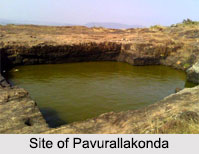 Visakhapatnam or Vizag is a coastal, port city in the Indian state of Andhra Pradesh, which is also the largest city and financial capital of the state. It is located on the eastern shore of India, nestled among the hills of the Eastern Ghats and facing the Bay of Bengal to the east. This city is also the administrative headquarters of Visakhapatnam District and is the home of the Eastern Naval Command of the Indian Navy. Sometimes Visakhapatnam goes by its presently mostly obsolete colonial British name, Waltair. It is sometimes also referred to as the "City of Destiny". Visakhapatnam is home to several state owned heavy industries; one of the most advanced steel plants and one of the country`s largest ports and its oldest shipyard are among them.
Visakhapatnam or Vizag is a coastal, port city in the Indian state of Andhra Pradesh, which is also the largest city and financial capital of the state. It is located on the eastern shore of India, nestled among the hills of the Eastern Ghats and facing the Bay of Bengal to the east. This city is also the administrative headquarters of Visakhapatnam District and is the home of the Eastern Naval Command of the Indian Navy. Sometimes Visakhapatnam goes by its presently mostly obsolete colonial British name, Waltair. It is sometimes also referred to as the "City of Destiny". Visakhapatnam is home to several state owned heavy industries; one of the most advanced steel plants and one of the country`s largest ports and its oldest shipyard are among them.
Etymology of Visakhapatnam
The name Visakhapatnam has been derived from the temple name "Vaisakha", which was built by a king of 4th century. The king was on a pilgrimage and had to halt at the Lawson"s Bay. There he built the temple, which later got submerged under the sea but the name of the temple has been derived to name the city.
History of Visakhapatnam
The history of Visakhapatnam dates back to the 6th century almost. The city finds its mention in the ancient books of "Panini" and "Katyayana" of 4th century. According to the historians, present Visakhapatnam was built in 11th or 12th century during the Chola Dynasty. From Chola dynasty to Gajapati dynasty, Mughal dynasty and lastly British invasion, the city of Visakhapatnam has seen many rulers to control its administrations. The British captured the city in 1804 after the Battle of Vizagapatam and it remained under the British rule till the Indian Independence of 1947. Visakhapatnam is highly influenced by Buddhism and possesses many Buddhist sites.
Demography of Visakhapatnam
According to the 2011 census data, population of Vishakhapatnam is almost 1,728,128, out of which males are 873,599 and females 854,529. 164,129 of the total population come under the age of 6 years. Average literacy rate of Vishakhapatnam is 81.79% of which 688,678 are males and 590,459 are females. Vishakhapatnam is the 122th city among the fastest growing cities in the world.
Climate of Visakhapatnam
Vishakhapatnam possesses a tropical and wet and dry climate with maximum temperature in the month of May and minimum in January. South-west and North-east monsoons bring rainfall in this region and the annual rainfall of Vishakhapatnam is 1,118.8 mm.
 Language of Vishakhapatnam
Language of Vishakhapatnam
Visakhapatnam is mainly a Telugu speaking city. The Telugu spoken by the middle classes is a standard dialect, while a considerable population who has settled down in the city from neighboring villages and neighbouring districts of East Godavari, Vizianagaram and Srikakulam speak Uttarandhra (North Coastal) Mandalikam dialects.
Largest Harbour in Vishakhapatnam
Vishakhapatnam has the only natural harbour on the eastern coast of India. Its saga began with the expedition of British to find a suitable port that could serve the neighborhood possessing rich mineral wealth. Vizag is the most sheltered natural harbour in Asia. The British started building the harbor in 1927 and in 1933 it was opened to carry out traffic.
Industries in Vishakhapatnam
The most important industry in Vishakhapatnam is setting up of Scindia Steam Navigation Co. that was later known as Hindustan Shipyard Ltd in 1940. In 1950s and 1960s Government and private sector setting up some large-scale basic industries in Visakhapatnam like Bharat Heavy plates and vessels (B.H.P.V.), Hindustan Zinc Ltd., Caltex oil refinery (Later acquired by government as H.P.C.L.), Coramandel fertilizers, Andhra Polymers (Now L.G. Polymers), etc. 1980s saw a major growth with the development of Vizag Steel and other prime industries. Economic liberalization in the 1990s brought a humble growth to the city but not as much as it did to Hyderabad.
Tourism in Vishakhapatnam
The unspoilt beaches, nearby scenic beauty of Araku Valley and Borra caves, the 11th-century Simhachalam temple and ancient Buddhist sites of Vishakhapatnam like Pavurallakonda, Sankaram, Bavikonda, Thotlakonda attract tourists round the year. Visakhapatnam also boasts a submarine museum, the first of its kind in South Asia, at Rama-Krishna Beach. Indira Gandhi Zoological Park was setup in 1972 in the fringes of Visakhapatnam. The Zoo Park features some of the most special species in India.
Transportation to Vishakhapatnam
Vishakhapatnam railway station and Vishakhapatnam airport connect this city to other major parts of India. National Highway 16 is the prime medium to get connected to Vishakhapatnam by road.



















